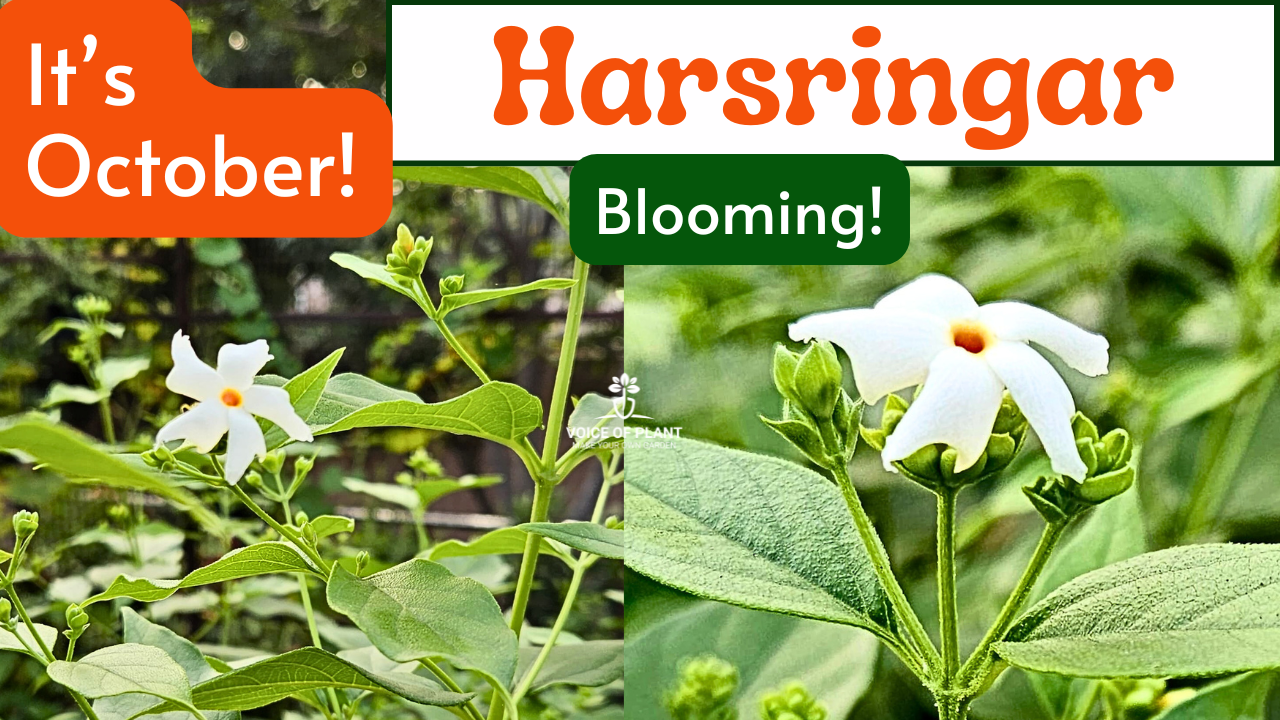Harsringar (Parijat) Flowering Tips
I’m excited to share that my beloved Harsringar, also known as Parijat or Night-blooming Jasmine, has finally started flowering today, on 1st October.
This plant is special to me, not just for its beauty but because it has a fascinating blooming cycle. For nine months of the year, the Harsringar waits patiently, and as soon as October arrives, it bursts into bloom almost as if on cue. It’s no wonder we sometimes call it the “October Plant.”
The flowers of Harsringar are also deeply rooted in tradition and culture. These flowers are often used in worship during Durga Puja and Navratri celebrations, making them sacred to many.
But what do you do if your plant isn’t flowering? Don’t worry! Below, I’m sharing Harsringar (Parijat) flowering tips that can help encourage your Parijat to bloom.
Expert Tips to Make Your Parijat Bloom
1. Do Light Pruning
If your Harsringar is not flowering, light pruning is one of the first steps you should take.
Pruning encourages the plant to focus its energy on new growth and flower production.
- Trim away dead or old branches to stimulate fresh blooms. Just be careful not to overdo it—light, precise pruning works best!
2. Use Banana Peel Liquid Fertilizer
The right nutrients can make a world of difference for your Harsringar. One effective, natural fertilizer is banana peel liquid fertilizer.
Banana peels are packed with potassium, which helps with flower production.
Note:
- To make it, simply soak banana peels in water for a few days and use the liquid to feed your plant.
- This can boost flowering and improve the overall health of the plant.
Click here to read: How to make & use Banana Peel Fertilizer on Plants
3. Spray Seaweed Liquid Fertilizer
Seaweed liquid fertilizer is another great option to help your Harsringar bloom.
- Rich in trace minerals and essential plant growth hormones, it promotes healthier growth and helps plants recover from stress.
- A light spray every few weeks can do wonders for your Parijat, especially if it’s struggling to produce flowers.
Click here to read: Seaweed Fertilizer Benefits & Uses
4. Water Regularly
After pruning and fertilizing, it’s crucial to water your plant regularly.
While Harsringar doesn’t need to be waterlogged, it does appreciate consistent moisture.
- Aim for even watering without letting the soil dry out completely.
- Too much or too little water can both prevent flowering, so keep the balance right.
Click here to read: Harsringar Plant Complete Care Tips
5. Ensure Proper Sunlight Exposure
One of the most important factors in encouraging blooms on your Harsringar is adequate sunlight.
This plant thrive in sunlight and need about 3 to 4 hours of direct light each day.
- If your plant is not flowering, it could be because it’s not getting enough light.
- Consider moving it to a sunnier spot to ensure it’s receiving enough rays to encourage flowering.
Enrich the Soil with Organic Compost
A plant is only as healthy as the soil it’s growing in. Harsringar needs soil that is rich in organic matter.
- Adding compost to your plant’s soil ensures it has all the nutrients it needs to produce flowers.
- Organic compost improves soil texture, provides essential nutrients, and enhances moisture retention, all of which are beneficial for flowering.
Check the Pot Size and Drainage
Sometimes, plants can stop flowering if they’re root-bound or if there’s poor drainage in their pot.
If your Harsringar has been in the same pot for a long time, consider repotting it into a larger container with good drainage holes.
- This will give the roots more room to grow and prevent water from stagnating, which can cause root rot.
Conclusion
Seeing my Harsringar burst into bloom every October is a joyful reminder of the beauty of nature and the reward of patient gardening. If your plant isn’t flowering, don’t despair—just follow these expert tips! With a little care and attention, your Parijat will soon be blooming and filling your space with its delightful fragrance.
Follow our Social media channel:
2. Voice of Plant Facebook Page
3. Instagram Voice of Plant Channel
Happy gardening!
